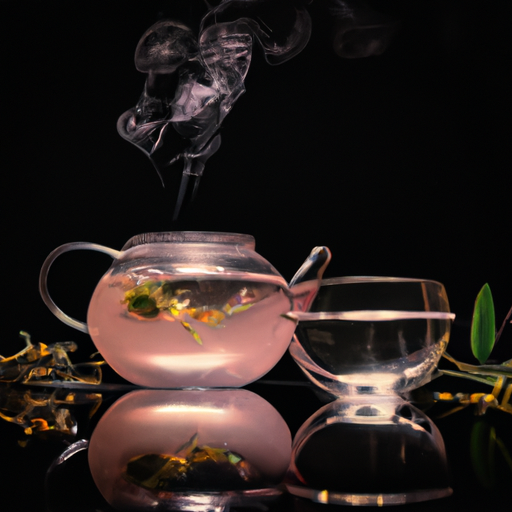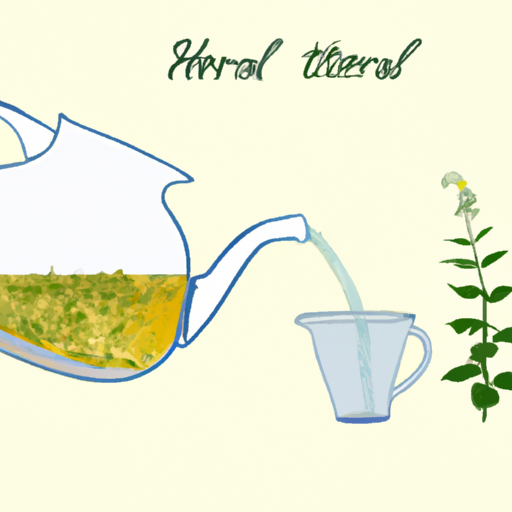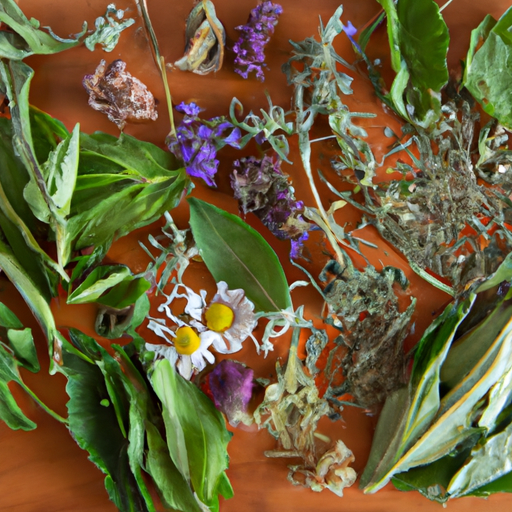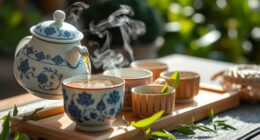Steeping herbal tea is like unlocking a treasure chest of health and flavor. It’s a journey that requires time and patience, but the rewards are worth it.
Imagine savoring a cup of tea that not only delights your taste buds but also nourishes your body and mind. That’s the magic of steeping herbal tea to perfection.
In this article, I will guide you on how long to steep herbal tea to reap the maximum benefits. Through research and personal experience, I have discovered the ideal steeping times that bring out the full potential of these natural wonders.
By understanding the science behind steeping, we can enhance the flavor and aroma of our herbal tea. But it doesn’t stop there. Steeping for the right amount of time also allows us to unlock the health benefits that these herbs offer, from boosting immunity to calming the mind.
So, grab your favorite herbal tea blend, a cozy mug, and join me on this journey of steeping perfection. Let’s explore the art of steeping herbal tea and discover the incredible benefits it has to offer.
Key Takeaways
- Steeping herbal tea for 5-7 minutes at 200°F (93°C) is a general rule, but adjust steeping time for lighter or stronger flavor.
- Experiment with steeping times to explore different taste dimensions and find the ideal steeping time for personal preference.
- Recording observations in a tea journal helps identify the best steeping time for each herbal tea and avoid over-steeping.
- Seek recommendations from tea experts to enhance the steeping process, including insights on temperature, methods, ratio, and relaxation techniques.
Understanding Herbal Tea Steeping Times
Herbal tea steeping times can vary, so it’s important to understand how long to steep in order to unlock the full potential of its benefits. The optimal steeping time for herbal teas depends on the specific herbs used and the desired strength of the infusion.
Generally, herbal teas require a longer steeping time compared to other types of tea. A good rule of thumb is to let the herbs steep for about 5-7 minutes. This allows enough time for the water to extract the beneficial compounds from the herbs. However, some herbs may require a longer steeping time, up to 10 minutes, to fully release their medicinal properties.
By maximizing infusion time, you can ensure that you are getting the most benefits from your herbal tea. Now let’s move on to how to maximize flavor and aroma without compromising the benefits.
Maximizing Flavor and Aroma
Brewing your cup of natural goodness is like coaxing a fragrant symphony of flavors and scents to dance upon your taste buds. To maximize aroma and enhance taste, it’s important to pay attention to the steeping process. Here are three key tips to make the most of your herbal tea experience:
-
Use freshly boiled water: Hot water helps release the aromatic compounds in herbal tea, resulting in a more flavorful brew.
-
Steep for the right amount of time: Different herbal teas require different steeping times, so follow the instructions on the packaging or consult a trusted source to ensure optimal flavor extraction.
-
Cover your cup while steeping: This traps the volatile compounds, preserving the aroma and preventing it from escaping.
By maximizing aroma and enhancing taste, you’ll be one step closer to unlocking the health benefits of herbal tea.
Unlocking the Health Benefits
To truly unlock the health benefits of your cup of goodness, it’s crucial to understand the power of proper steeping techniques. Herbal teas are known for their numerous health benefits, such as boosting immunity, aiding digestion, and reducing inflammation. However, to maximize these benefits, it’s important to steep your herbal tea for the optimal amount of time.
Each herb has its own recommended steeping time, which can range from 5 to 15 minutes. This allows the water to extract the beneficial compounds and flavors from the herbs. Steeping for too short a time may result in a weak infusion, while steeping for too long can lead to a bitter taste. By finding the perfect balance, you can ensure you’re getting the most out of your herbal tea.
Transitioning into the next section, let’s explore how to avoid bitterness and over-steeping.
Avoiding Bitterness and Over-Steeping
When it comes to herbal tea, it’s important to avoid over-steeping to prevent bitterness. Signs of over-steeping include a strong, bitter taste and a darker color.
To prevent bitterness, I recommend adjusting the steeping time based on personal preference. If you prefer a milder flavor, steep for a shorter time, and if you prefer a stronger flavor, steep for a longer time.
Signs of Over-Steeping
If you leave the herbal tea steeping for too long, you’ll notice a deep, dark color filling the cup, resembling the shade of a moonless night. Over-steeping herbal tea can have some consequences that you’ll want to avoid. Here are five signs that your tea is over-steeped:
-
Bitter taste: Over-steeping can lead to a strong, bitter taste that may be unpleasant.
-
Tannins: The longer you steep, the more tannins are released, resulting in a dry and puckering sensation in your mouth.
-
Astringency: Over-steeping can make the tea overly astringent, leaving a drying feeling on your tongue.
-
Loss of aroma: Extended steeping can cause the delicate aromas of the herbs to dissipate, resulting in a less flavorful tea.
-
Discoloration: The tea may become darker and cloudier due to the release of compounds from the herbs.
To prevent bitterness and ensure a flavorful cup of herbal tea, it’s essential to know how to steep properly.
How to Prevent Bitterness
To prevent bitterness in your cup, it’s important to pay attention to the steeping time and temperature. Herbal teas can easily become bitter if steeped for too long or at too high a temperature. To avoid this, follow the recommended steeping time and temperature for each type of herbal tea.
Generally, herbal teas should be steeped for 5-7 minutes at a temperature of 200°F (93°C). Steeping for longer than the recommended time can result in an overly strong and bitter taste. Additionally, using water that is too hot can extract more tannins from the tea leaves, leading to bitterness.
By steeping your herbal tea for the right amount of time and at the correct temperature, you can prevent bitterness and enhance the flavor of your cup.
Now, let’s explore how to adjust the steeping time for personal preference.
Adjusting Steeping Time for Personal Preference
For a more personalized taste experience, adjust your steeping time according to your own preferences, allowing the flavors to dance and unfold in your cup.
Here are some tips to help you adjust the flavor and strength of your herbal tea:
- Decrease steeping time for a lighter, more delicate taste.
- Increase steeping time for a stronger, bolder flavor.
- Experiment with different steeping times to find your preferred strength.
Keep in mind that some herbal teas may become bitter if steeped for too long.
Don’t be afraid to try shorter or longer steeping times to discover new dimensions of taste.
By adjusting the steeping time, you have the power to customize your herbal tea experience.
In the next section, we’ll explore the art of experimenting with steeping times to unlock even more flavors and aromas.
Experimenting with Steeping Times
When it comes to steeping herbal tea, I’ve found it beneficial to try different steeping times. This helps me discover the perfect balance of flavor and health benefits. By experimenting with steeping times, I find the optimal duration that brings out the desired flavors and aromas without causing bitterness from over-steeping.
To keep track of my findings, I’ve started keeping a tea journal. In this journal, I record the steeping times and the resulting taste profiles. It’s a great way for me to document my experiences and learn from them.
In addition to my own experiments, seeking recommendations from tea experts has been invaluable. They guide me towards the ideal steeping times for different types of herbal teas. Their expertise helps me avoid any guesswork and ensures that I get the most out of my tea.
Trying Different Steeping Times
Experiment with different steeping times to find the perfect balance between flavor and maximum health benefits. Did you know that steeping herbal tea for 5 minutes extracts about 60% of its antioxidants, while steeping for 10 minutes extracts about 80%? Finding the optimal time for steeping your herbal tea can make a significant difference in the benefits you receive.
Here are a few things to consider:
- Start with the recommended steeping time on the packaging, but don’t be afraid to adjust it to your liking.
- Try steeping for shorter periods of time to preserve more delicate flavors.
- Experiment with longer steeping times to extract more antioxidants and other beneficial compounds.
- Keep in mind that some herbal teas may become bitter if steeped for too long.
- Pay attention to how different steeping times affect the taste and aroma of your tea.
By keeping track of your experiments in a tea journal, you can easily identify the steeping time that provides the best balance of flavor and health benefits.
Transitioning into the next section, let’s explore the importance of keeping a tea journal.
Keeping a Tea Journal
Keeping a tea journal allows me to fully immerse myself in the world of tea, capturing the subtle nuances of each brew and unlocking a deeper understanding of my personal preferences and the intricate flavors that can be discovered.
By recording my observations, I can track the different tea flavors I’ve tried and note which ones I enjoy the most. This helps me remember which teas to purchase again and which ones to avoid. Additionally, it allows me to experiment with steeping times and see how they affect the flavor profile of the tea.
Through my tea journal, I’ve discovered that certain herbal teas benefit from longer steeping times, while others are best with a shorter infusion. By keeping track of my experiences, I can make more informed decisions about how long to steep my herbal teas to get the most benefits.
Transitioning into seeking recommendations from tea experts, I can now confidently ask for advice on specific tea flavors and steeping methods.
Seeking Recommendations from Tea Experts
One of the best ways to enhance my tea experience is by consulting tea experts for their recommendations. They have extensive knowledge about tea brewing techniques and can provide valuable insights on the best practices for steeping herbal tea.
Here are some key recommendations from tea experts:
-
Use the right water temperature: Different herbal tea varieties require different water temperatures for optimal steeping. For example, delicate herbal teas like chamomile should be steeped in water that’s around 190°F, while stronger herbal teas like peppermint can handle boiling water.
-
Follow the recommended steeping time: Steeping herbal tea for the right amount of time is crucial to extract the maximum benefits. Most herbal teas require 5-7 minutes of steeping, but some may need longer or shorter times depending on their ingredients.
-
Experiment with steeping methods: Tea experts suggest trying different steeping methods, such as using a tea infuser or brewing loose tea in a teapot, to find the one that suits your taste preferences.
-
Consider the water-to-tea ratio: Maintaining the right ratio of water to tea leaves is important for achieving the desired flavor and strength. Tea experts recommend using 1 teaspoon of loose tea or one tea bag per 8 ounces of water.
-
Don’t forget to relax and enjoy: Tea brewing is an art and a ritual. Take your time to savor the aroma and flavors of your herbal tea while practicing mindfulness.
Considering these recommendations from tea experts, it’s important to also take into account other factors that can influence the steeping process, such as water quality and the freshness of the tea leaves.
Other Factors to Consider
To really maximize the amazing benefits of herbal tea, you’ll want to steep it for a ridiculously long time! When it comes to maximizing the steeping potential of herbal tea, it’s important to understand the different types of tea.
Some herbal teas, like chamomile or peppermint, release their flavors and health benefits quickly, so a shorter steeping time of around 5-7 minutes is sufficient. On the other hand, herbal teas made from roots, barks, or seeds, such as dandelion or cinnamon, require a longer steeping time of 10-15 minutes to fully extract their beneficial properties.
Additionally, the temperature of the water plays a crucial role. Boiling water can be used for most herbal teas, but if you’re using delicate flowers or leaves, it’s best to use water that is just below boiling point.
By understanding these factors and adjusting your steeping time accordingly, you can ensure that you’re getting the most out of your herbal tea.
Frequently Asked Questions
Can I use the same steeping time for all types of herbal tea?
No, different types of herbal tea require different water temperatures and steeping times. For example, green herbal tea should be steeped at a lower temperature for a shorter time to preserve its delicate flavors and maximize its benefits.
How does the water temperature affect the steeping time of herbal tea?
Water temperature greatly affects the flavor of herbal tea. Steeping at higher temperatures can result in a stronger, more robust flavor, while lower temperatures yield a milder taste. There is a recommended water temperature for steeping herbal tea, which varies depending on the specific type of tea.
Does the size of the tea leaves affect the recommended steeping time?
The size of tea leaves affects the flavor profile. Different brewing techniques are recommended for different sizes. It’s important to consider leaf size when steeping herbal tea for optimal flavor extraction.
Can I reuse the same tea leaves for multiple steepings?
Yes, you can reuse tea leaves for multiple steepings. It’s a great way to get the most out of your tea. Experiment with alternative steeping methods like longer steep times or cold brewing to extract different flavors and benefits.
Are there any specific herbal teas that require longer or shorter steeping times for maximum benefits?
Steeping techniques for herbal teas vary depending on the specific type. Factors like tea leaves size, temperature, and desired flavor intensity influence steeping time. For maximum benefits, some herbal teas require longer steeping to extract their full potential.
Conclusion
In conclusion, steeping herbal tea for the right amount of time is crucial in order to fully reap its benefits. By following the recommended steeping times, we can maximize the flavor, aroma, and health benefits of our herbal teas.
Additionally, avoiding over-steeping is important to prevent bitterness. Remember, as with most things in life, finding the perfect steeping time may require some experimentation.
So, go ahead and explore the world of herbal teas, and don’t be afraid to think outside the box – after all, variety is the spice of life!










